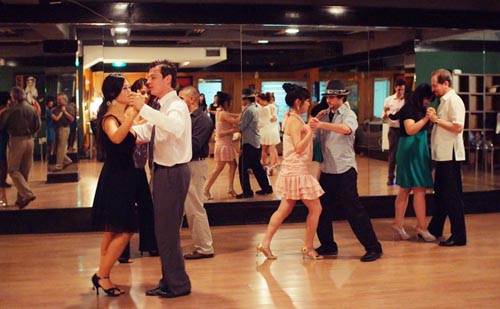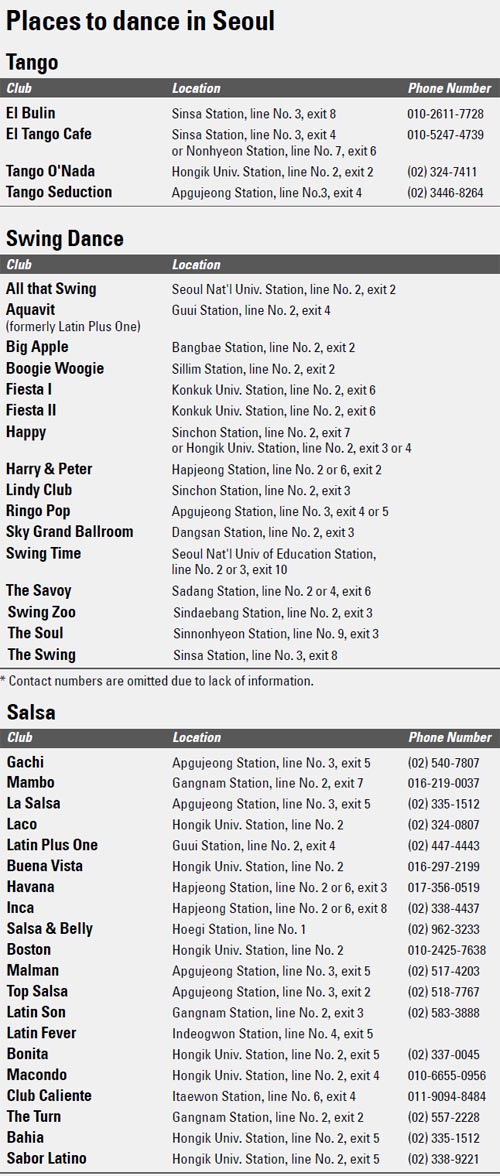Classes offer a cure for those with two left feet

Joey Bzdel and Helen Kim, left, the couple behind You Can Dance Studio, lead a recent class. By Chris Bateman
Just navigating daily life can occupy most of your free time, leaving little room to take up new interests. It can also be difficult to find the resources to start up a new hobby.
But expats interested in dancing are in luck, as the country boasts a thriving community offering classes for everyone from beginners who step on their own feet to those who can command a club floor with their moves.
Tango
Tango, the mysterious and seductive dance that Unesco recently deemed to be part of the world’s “intangible cultural heritage,” is beginning to gain some popularity here in Korea. The dance originated in Argentina and Uruguay and has both African and Spanish influences. It was originally a working-class dance form. After gaining steam in Europe and North America, the dance as we know it today is often a part of ballroom dance competitions and has been the subject of or highlighted in various movies worldwide, indicating its international appeal.
As tango has become popular throughout the globe, it has taken many forms in different areas. The most notable differences stem from tango styles that follow an Argentine style versus those that follow ballroom styles - which can be further divided into “international” and “European” ballroom styles.
Major differences between the Argentine and ballroom styles revolve around the position of the body, specifically the dancers’ “embrace.” While Argentine tango’s embrace is based on close contact of the upper body, ballroom tango’s embrace often focuses instead on close contact of the lower body.
In Seoul, there are a few major clubs that have become pillars for the tango scene in the country. Clubs typically offer both class instruction as well as “milonga” schedules, which provide open dance floors for an entrance fee. For more information on each clubs’ individual schedules, visit their Web sites or contact them directly.
In addition, from April 29 to May 3, Seoul will host the 2010 Seoul Tango Festival, where participants can learn tango in classes of various levels taught by three renowned tango pairs from Buenos Aires. Afterward, you can watch dance demonstrations. For more information about schedules and events, visit the event’s Web site at www.seoultangofestival.com.
Swing Dance
Named after the jazz music that spurred its creation, swing dancing mirrors its namesake music in many ways. It’s upbeat, energetic and improvisational. Moves sync up to match the rhythms, and dancers often flip, lift and spin their partners, making it an extremely exciting dance to watch and perform.
Swing dance is another style that has undergone many transformations over the years. An easy way to classify the dozens of styles is to categorize them into the larger groups of ballroom swing and jazz dance swing. Ballroom dance swing’s major forms are jive and East Coast swing. Jazz dance swing’s major forms are the Lindy Hop, the Balboa and the Charleston.
In Korea, swing dancing started to become popular around 2000, when Korean-American Alex Nah started to hold free swing classes in Boramae Park. It has since developed into one of the most popular dance forms in the country. In fact, nowadays you can find a place to swing nearly every night of the week.
For more information about swing dance bars, schedules and entrance fees, visit Kang Seok Kim’s blog at http://swingkorea.blogspot.com.
Salsa
People speculate that the term for the dance stems from the spicy sauce of the same name, as it describes the “hot” nature of the dance. Having originated in Cuba before spreading to the rest of Latin America, it is now popular around the globe. The rhythmic dance style, which features movements primarily of the hips and legs, is also becoming more popular in Korea.
Since the spread of salsa dancing began, many styles of the dance have developed, the most common being Cuban and American styles. American styles can be further categorized into New York and Los Angeles styles. Miami style salsa, with its huge Cuban population, is a fusion of both Cuban and American styles.
Most clubs in Korea play music to complement the Los Angeles style, but for those who are interested in Cuban or New York style dancing, you can visit La Salsa or Sabor Latino.
For those interested in learning salsa before venturing out to the clubs, there are a few places that offer salsa dance classes.
You Can Dance Studio - located near Itaewon Station - is owned and operated by expat dancer Joey Bzdel and his wife Helen Kim. Founded four years ago, the studio features classes taught by the couple, both of whom studied ballroom and Latin dance under famous Canadian dance coach William Jacobson. Classes are taught in English. Bzdel said that although he studied dance “seriously,” his approach to dance is to make sure students enjoy themselves first and then the steps will follow.
“Dance is not something you have to master before you can have a good time. You should have a good time first; that’s how you will master it,” he said.
The studio offers classes for a variety of dance styles, including Latin styles such as salsa and cha-cha and ballroom styles such as tango, foxtrot and waltz. Schedules change from month to month, so it’s best to contact them directly for more detailed information. You can contact them by phone (02) 749-3262 or send an e-mail message to youcandancekorea@gmail.com.
Candelo Studio, near Yangjae Station, offers both beginner and beginner-intermediate classes on Saturdays. The beginner-intermediate class is held from 4 to 5 p.m., followed by the beginner class from 5 to 6 p.m. Afterwards, members sometimes go out for social salsa dancing at a nearby club. One month of classes, which includes four lessons, is 60,000 won ($52.72). For more information, e-mail pillhwan@gmail.com or call 011-9046-6103.
Macondo, one of the oldest salsa clubs in Seoul, also offers evening lessons for all levels, often for free. The schedule changes from month to month, so check out their Web site for more information at http://www.macondo.co.kr.

By Shannon Heit Contributing writer [shannon.sgc@gmail.com]










with the Korea JoongAng Daily
To write comments, please log in to one of the accounts.
Standards Board Policy (0/250자)